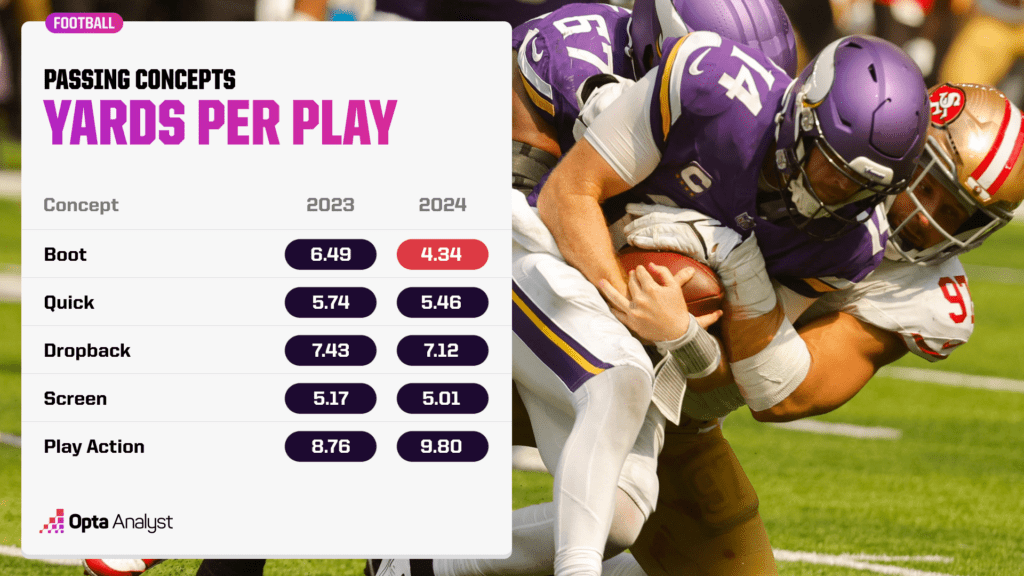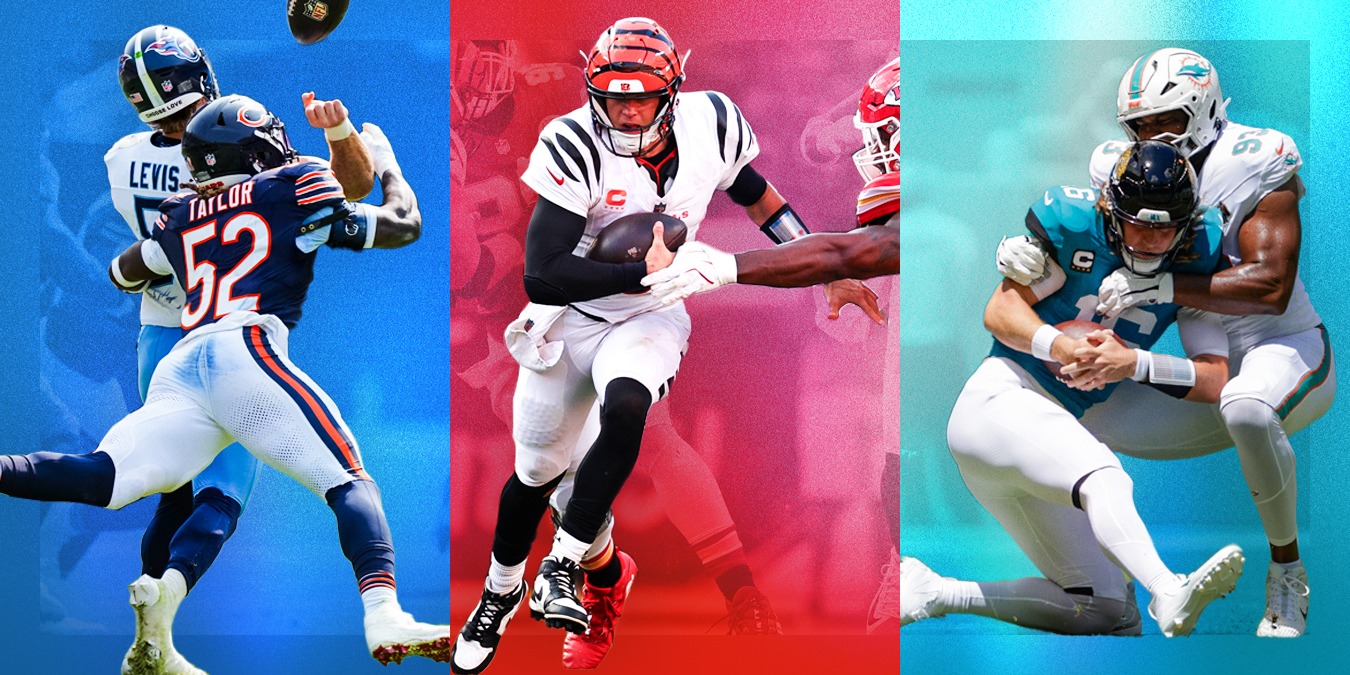There’s been a downward trend in scoring in the NFL in recent seasons. Through two weeks in 2024, there’s been a particular focus on passing offense. So what’s behind the limited 300-yard passing games and dip in plenty of other passing categories?
The NFL is back, and every quarterback is terrible!
Not really, but to the casual observer, it might seem that way.
Through two weeks, NFL teams are averaging the fewest passing yards in a season since 1992. Every year since 2020, the NFL has set a record for fewest yards per completion dating to at least 1931. But the change through two weeks this year is even more dramatic.
In 2020, the league averaged 11.10 yards per completion, and that number dropped to 10.89 last year. This season? It’s sitting at 10.55.
There have been a lot of theories thrown about as to why passing is down, and there is no one reason. Teams not playing as much in the preseason likely hurt offenses more than defenses early on. Per Mina Kimes of ESPN, teams are playing a high Cover-2 defense almost 60% of the time now to limit explosive plays, a dramatic shift in the last five years. We looked into scoring changes in the league in a similar context.
But there’s plenty of data to suggests that it’s not just about defenses playing two safeties back, and it’s not just limiting explosive plays. In past years, teams could expose defenses playing safeties back by dinking and dunking down the field.
Patrick Mahomes went from a gunslinger to someone who learned to be efficient on quicker throws while making the occasional magic happen downfield. Tom Brady was the master of death by a thousand cuts. And several other lesser QBs did a good enough imitation with the short passing game to drive offenses that didn’t run the ball very often.
And as the modern quarterback got more mobile, offenses got more creative about moving the pocket and putting defenders in no-win scenarios. Defenses are finally catching up, and there’s data to support why defenses’ abilities to take away these plays are behind the low-scoring atmosphere as much as anything.
These Boots Are Ugly
To look into what is truly driving passing numbers down this year, you can take a look at how well each passing concept is doing this year compared to last year in terms of success rate. The success of a play is defined by whether a team: 1.) gained half the yards needed toward a first down on first down; 2.) gained 70% of the yards needed toward a first down on second down; or 3.) got a first down or touchdown. Basically, did the offense achieve enough yards in a given situation to call it successful?
By isolating success rate by play concept, it becomes easier to see the culprit in offensive struggles this year. The success rate of boot concepts (or bootlegs) is down a whopping 14% through two weeks in 2024. No other passing concept is even down 3%.
Yards per play on each concept tells the same story. Boot concept plays are averaging just 4.34 yards per play this year, down 2.15 yards per play from last year. No other concept is down even half a yard. And the explosive play rate on boots is down 4.8% compared to last year, worse than any other passing concept.

Those numbers are all telling us the same thing: bootlegs are the plays in which success is down dramatically. Teams are being less efficient and having fewer explosive plays when running bootlegs.
Defending quarterbacks that move the pocket has been a challenge that defensive coaches have had a tough time solving until recently. But defenses have sold out this year in preventing quarterbacks from getting where they want to and have set defensive ends free to pursue the quarterback and ignore the run if needed.
It hasn’t been unusual to see a quarterback abandon the planned launch point because of pressure so far this season.
On this play, the defensive ends don’t care about the potential of a run at all, and pressure on Trevor Lawrence forces the quick pass to Christian Kirk that never has a chance to be a positive play.
It’s indicative of what’s been happening all over the league. Teams are more disciplined and more committed to stopping the bootleg before they even get started. Couple this with defenses doing a better job of hiding where the pressure is coming from (particularly when playing zone) than in years past, and bootleg concepts aren’t as simple to win as they used to be for offenses.
Run It Back
The problems facing passing games are extremely complex. The biggest solution is not: Run the ball.
Once upon a time, analytics were almost universally in favor of passing more often than even the most frequent passing teams were doing it. And teams didn’t need to have much balance if their quick passing game was good enough to move them down the field.
That’s not the case anymore. Yards per attempt on passes after more than 3 seconds has been pretty steady over the past five years and is actually up to 8.19 from 8.02 last year.
But yards per attempt on passes within 3 seconds has been in a fairly steady decline. Teams averaged 7.15 yards per attempt on those passes in 2018, 6.60 in 2023 and just 6.29 so far in 2024. The quick passing game is getting less and less efficient, and the pendulum needs to swing at least a little bit back in the other direction.
The numbers make sense when you watch plays like the Lawrence pass above. If defensive ends are that aggressive in containing the quarterback, it’s a lot harder for them to be involved in stopping the run. And teams are running the ball 40.6% of the time, up more than 2% from 2023.
And, with efficiency up as well on running plays, that number will likely continue to rise as teams try to counter what defenses are doing.
Teams might want to try more traditional play-action passes to complement the rushing game as well. Yards per play are up on these plays this year and are easily the highest of any concept (9.80 yards per play).
It’s still a challenge to block on these plays and call the right protections, but it’s also easier to win blocking Za’darius Smith with a tackle as opposed to blocking him with Gabe Davis.
The offensive geniuses in the league will surely adjust to the adjustments and find ways to make boots more effective again, and they’ll continue to find new ways to weaponize mobile quarterbacks.
But, until they do, a firmer commitment to the ground game could be beneficial to a lot of teams.
Be sure to check out our MLB, NBA, NFL and college football coverage. And follow us on X and Instagram for more.
